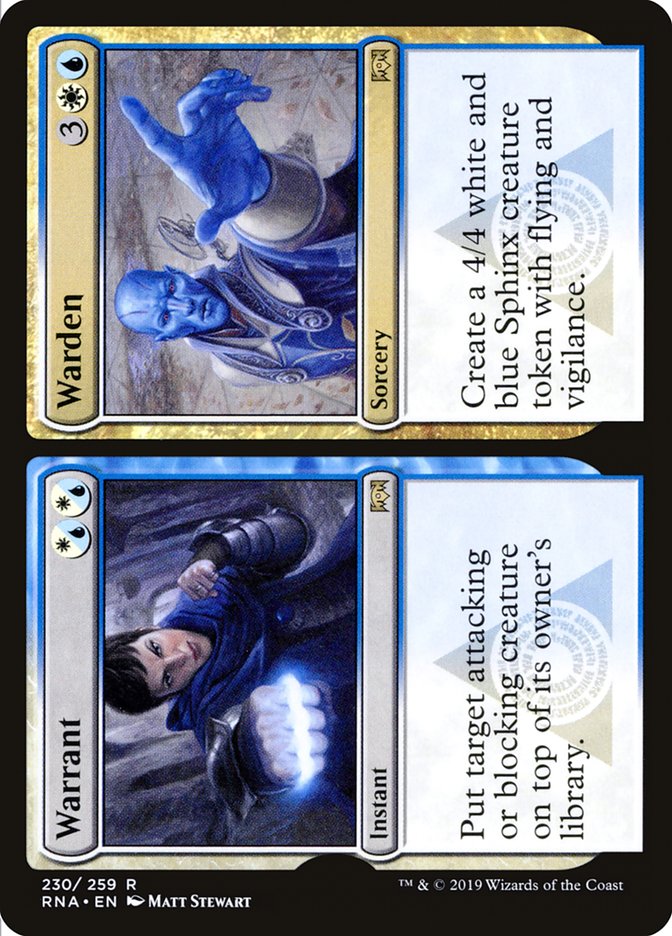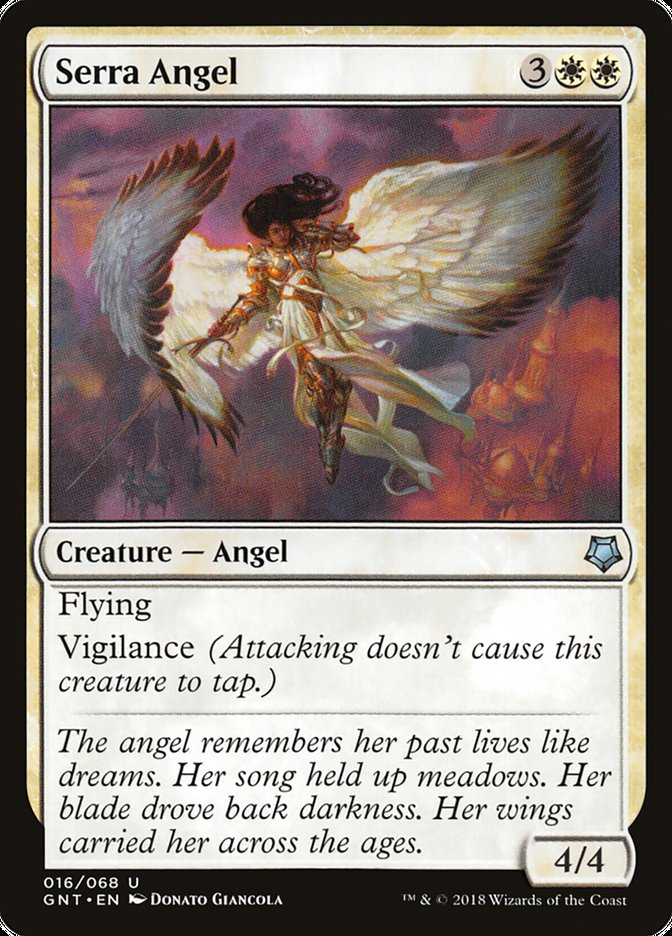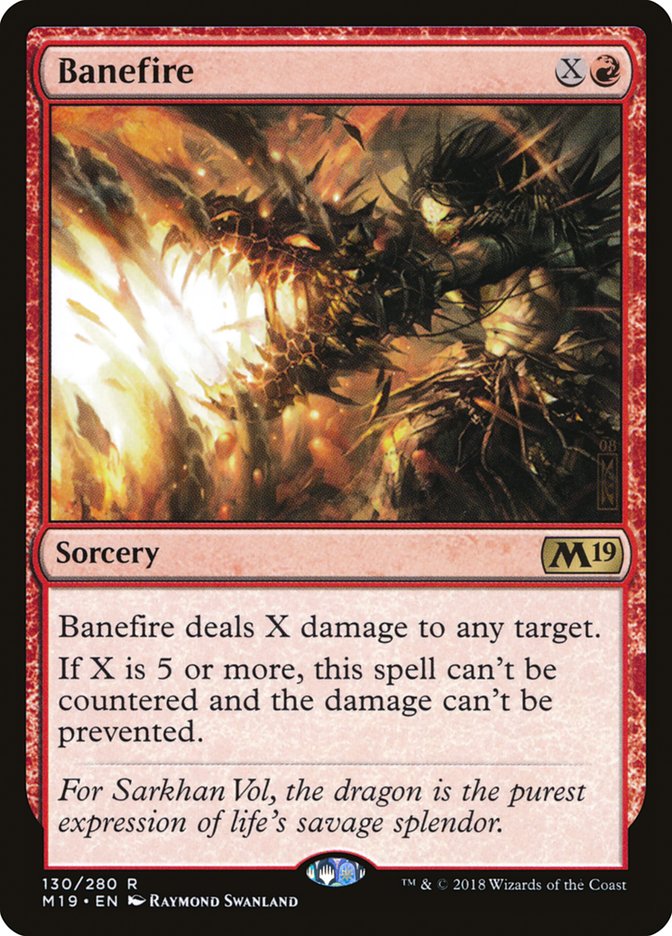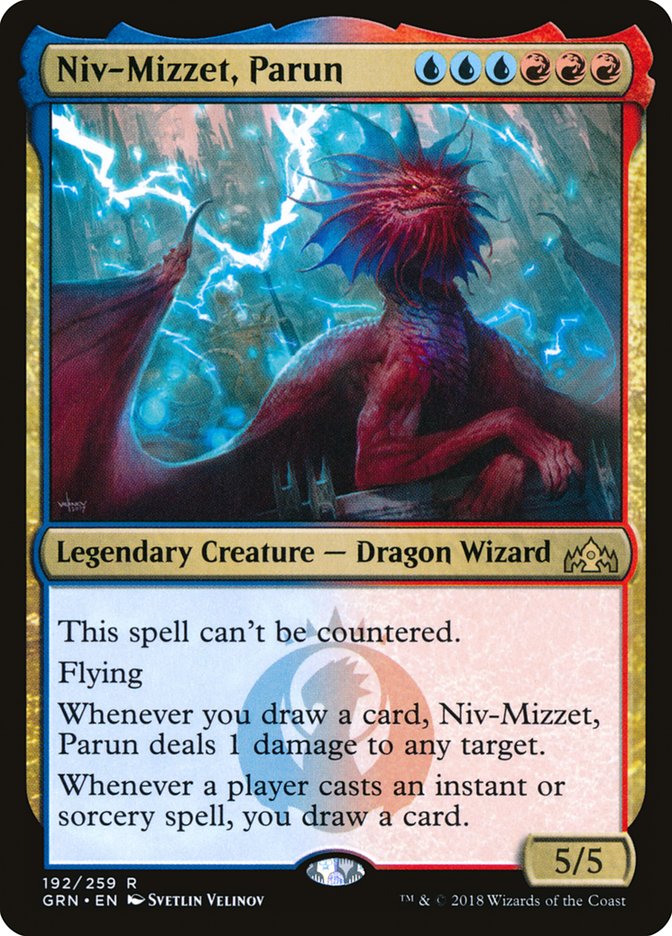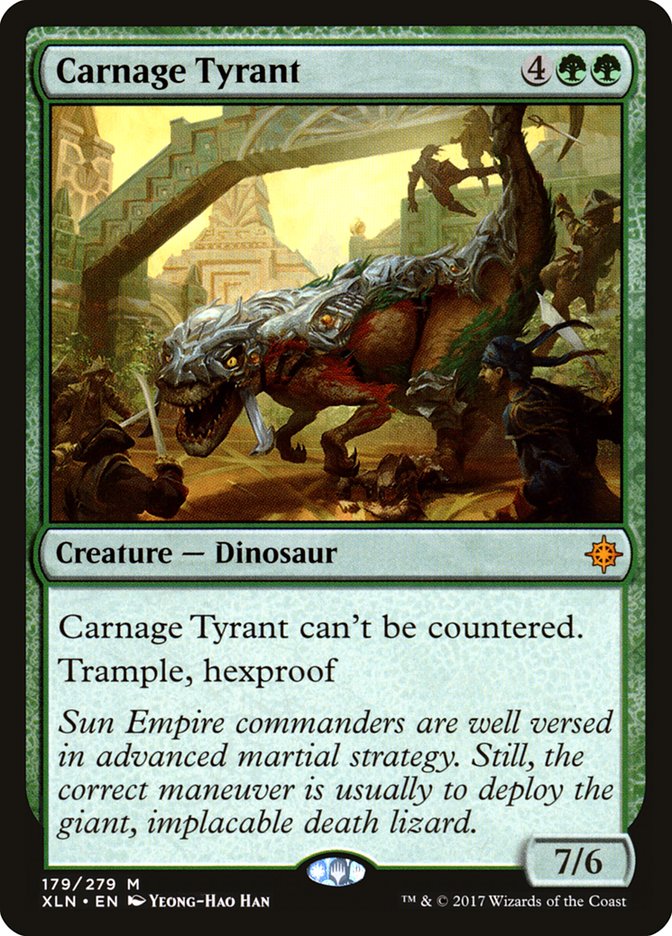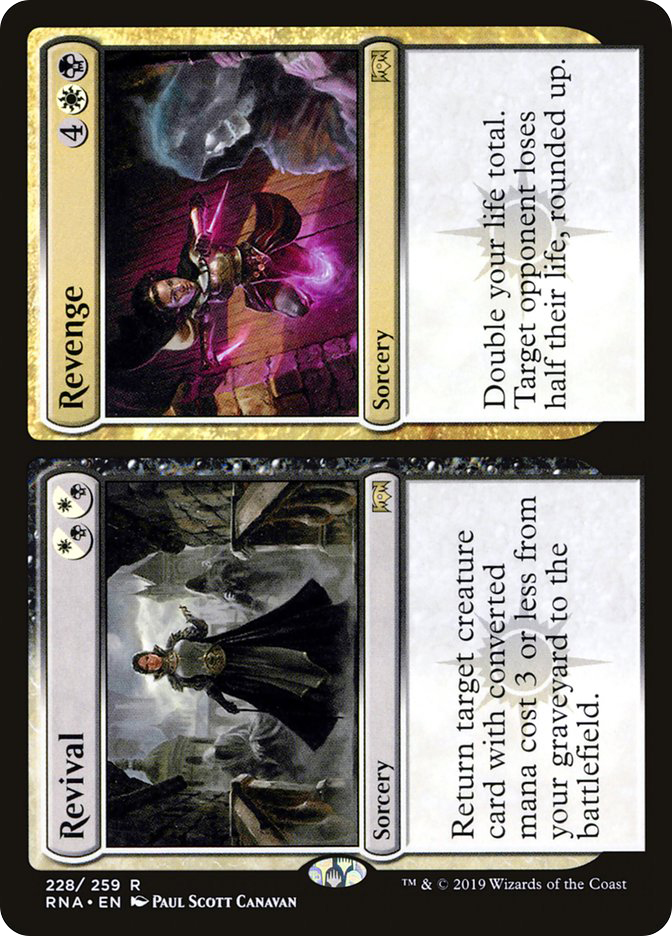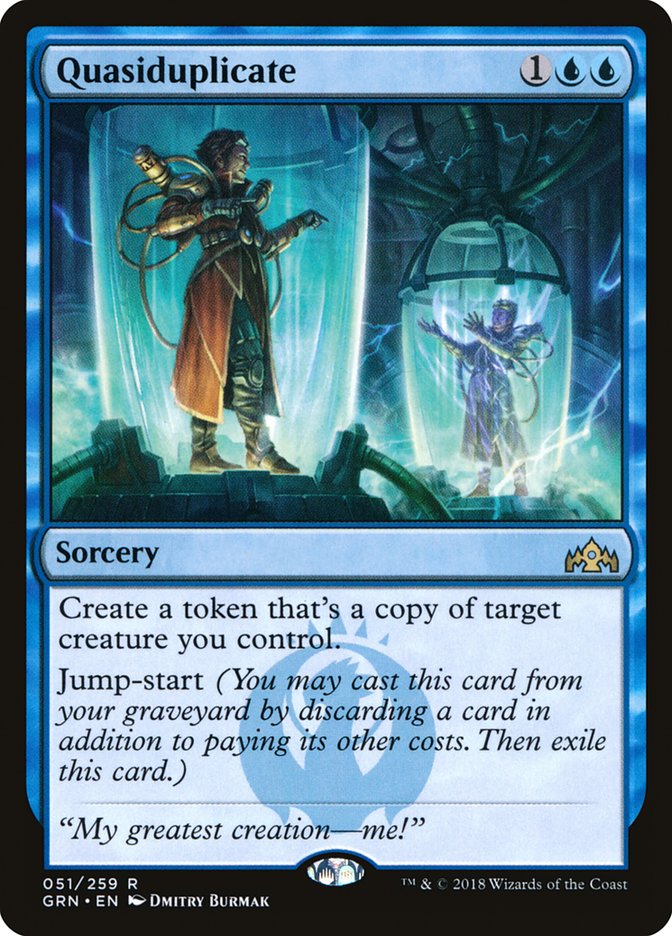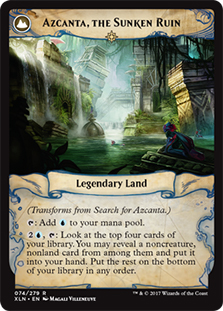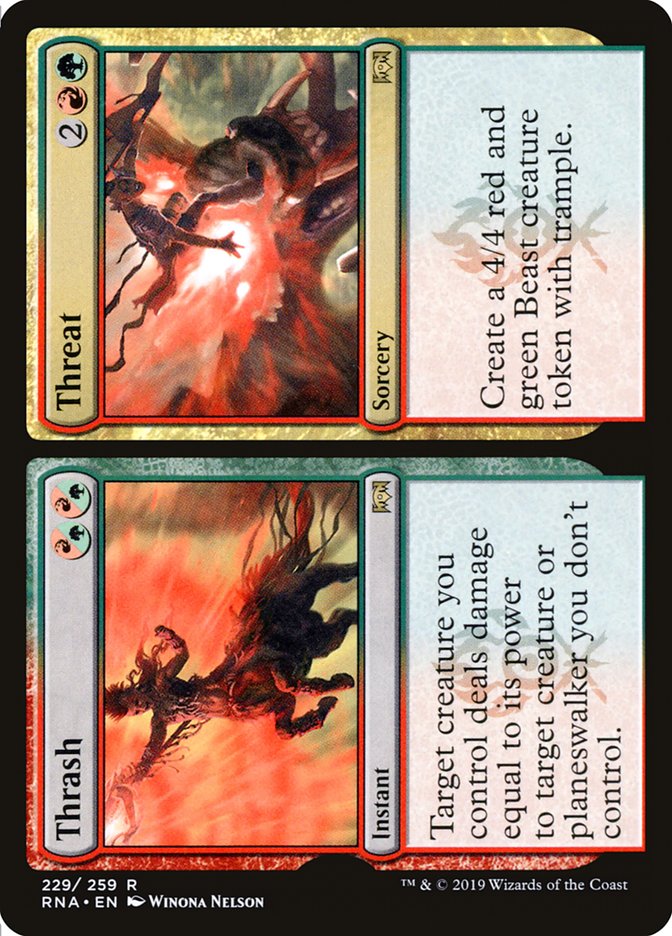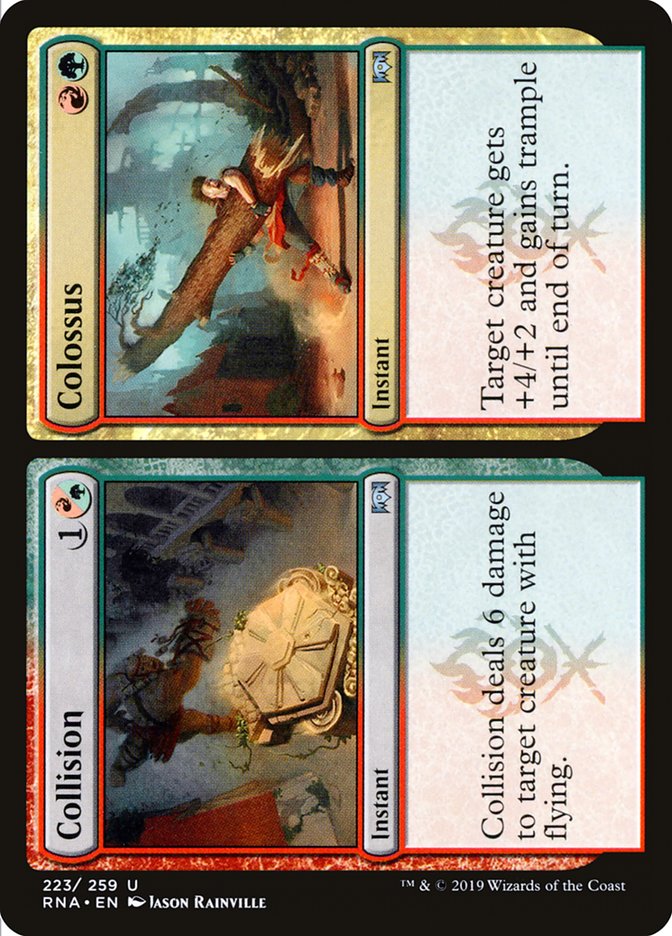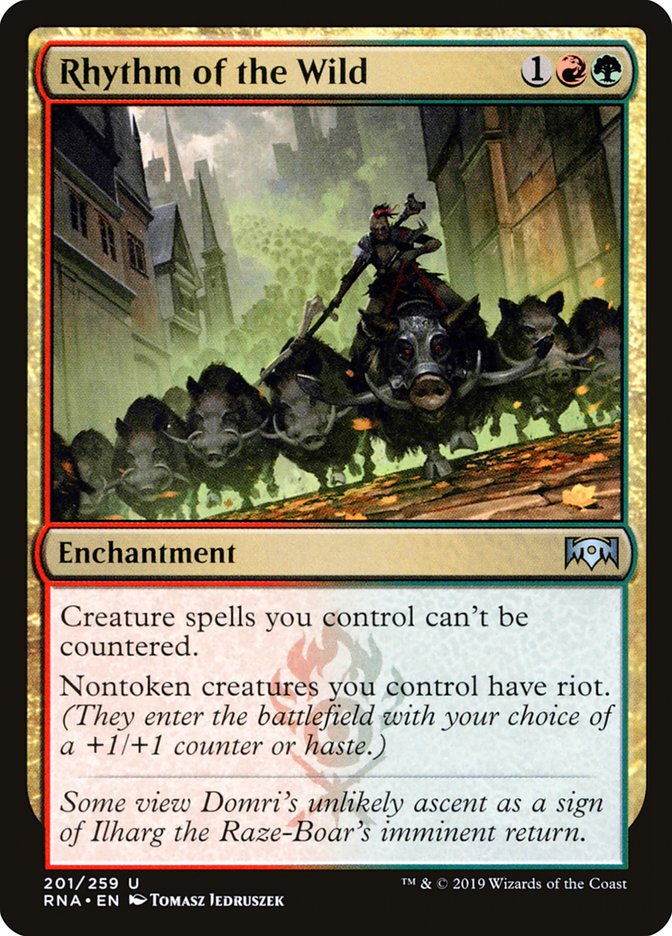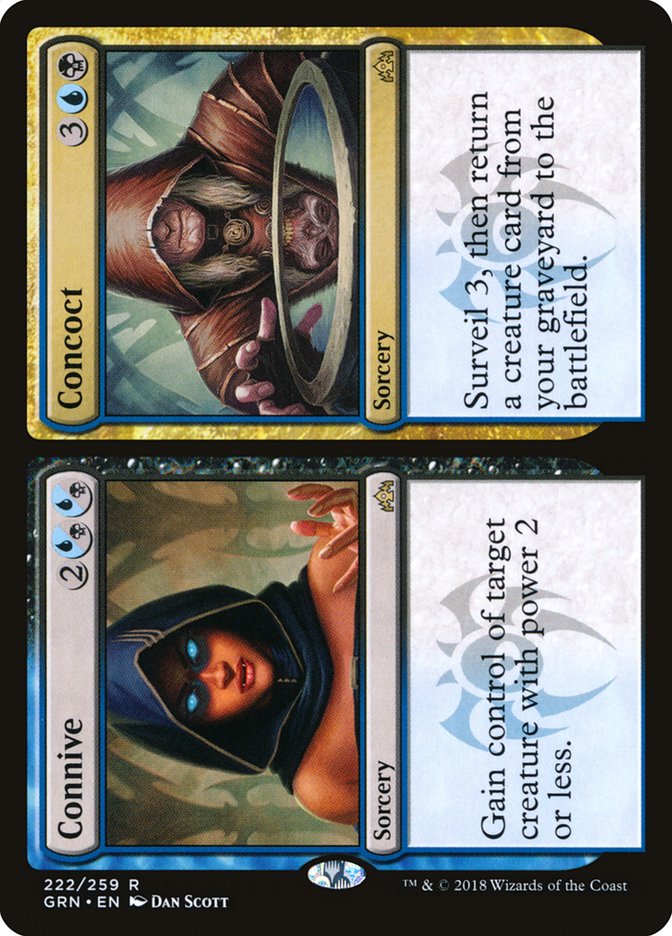Find//Finality and Expansion//Explosion have shown that Wizards of the
Coast aren’t messing around with the rare split cards in this block, and Ravnica Allegiance looks to bring some similarly heavy hitters. I
love the flexibility of these cards – combining both split cards and hybrid
mana with easily splashable back sides creates cards with an extremely wide
range of possible applications, and I like that they’re willing to push the
power level on these so that they can show up in Constructed.
Warrant//Warden
Warrant is incredible. It’s “the good mode” of Azorius Charm but strictly
easier to cast (in a very meaningful way), and instead of two other
two-mana modes, it has one five-mana mode. In general, cheaper effects are
better than more expensive ones, but on modal cards, the more different the
options are, the more powerful the card is overall. So a card with a cheap
mode and an expensive mode has much more meaningful flexibility, and thus
more power, than a card with two cheap modes. Basically, in either case,
the most common use of the card is going to be the shared mode, but it’s
better to have the option to cast Warden than the option to cast the other
modes on Azorius Charm because it does something totally different at a
totally different stage of the game.
Well, kind of.
I mean, that’s not a good proof, I’m just saying structurally, it’s the
right kind of thing – the actual power level depends on exactly
how powerful the effects are. Also, I’d concede that for a reactive modal
spell, having several different instant-speed options adds a layer of
flexibility that may be more valuable if you’re playing a deck that really
doesn’t ever want to cast a five-mana sorcery. Anyway, the real question
is, just how good is Warden?
Well, Warden is a card that WotC told us they wouldn’t print – a U/W 4/4
creature with flying and vigilance.
This is allegedly supposed to be a B/G card
, but we get access to it in a U/W deck, which is, I guess, pretty
exceptional. /end troll
Still not black and/or green.
Okay, so it’s basically a Serra Angel, but it’s a token, so it’s a little
less durable (dies to bounce effects). Serra Angel is nowhere near the
power curve of modern day Constructed creatures, but it is objectively a
reasonably effective way to end a game you’ve taken control of. This means
that “100% interactive spells, wins with Teferi” Azorius Control decks can
now actually end the game, which will be better for everyone. Basically,
you never want to have to rely on this to catch you up or stabilize a
battlefield, but this lets you end the game in a reasonable time frame once
you’ve taken control. Putting this card on a removal spell is kind of
weirdly similar to reprinting Celestial Colonnade. Either informs how a
true control deck will actually end the game, but that has very little to
do with how it will really win the game, if that distinction is
clear.
Sidenote in case it isn’t clear: Understand that when one deck has
inevitability, the game is contented in the early stages, and effectively
won when the control deck takes over – it’s the first time your opponent
had to pass their turn without a threat on the battlefield that you really
won the game a lot of the time, for example. The rest is just paperwork.
Now I may be talking down the importance of actually closing the game, but
the reality is that it does add real percentage points to control decks.
The more games you end after taking control, the fewer games you lose to a
Banefire, Niv-Mizzet, Parun, or Carnage Tyrant after you thought you were
in the clear.
The other big deal about Warrant is that it’s hybrid. This doesn’t just
mean it’s easier to cast in Azorius decks – though it does mean that and
that matters – it also means that it can go in blue or white
decks. For a white deck, this is nothing special. Seal Away already exists,
but this is the kind of hybrid card that bleeds the color pie a little.
This isn’t really an effect blue gets at this rate. This means mono-blue
decks have access to a more powerful removal spell than normal, and it
means Izzet decks have a much better answer to Adanto Vanguard.
I suppose I’ve been implying without explicitly stating, yes, this card is
great with Teferi, Hero of Dominaria specifically. Obviously a two-mana
instant that protects Teferi is exactly what Teferi can’t get enough of. I
this the future looks pretty hostile for control decks, honestly, but if
there’s an Azorius control deck, this will certainly be a part of it.
Revival//Revenge
Revival looks like a reasonable card. You can get a three-mana creature for
two mana, so there’s some value there. My first thought was that it’s good
with something like Fulminator Mage, which is a three-mana creature that
puts itself in the graveyard, but at the point that I started thinking
about Faithless Looting into Revival, I realized that I was just building
the worst Reanimator deck in history and now I’m thinking that it’ll take a
really specific three-mana creature to see this succeed where Claim failed.
That leaves Revenge to do the heavy lifting for this card. Yeah, I have bad
news on that front. I’d love a good Orzhov split card, but that’s just not
what we have here. I doubt I’ll ever write this card on a decklist.
Repudiate//Replicate
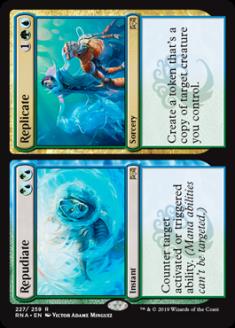
Stifle is a weird card. It’s seen a lot of play, but it’s unlikely to have
seen any of it if fetchlands didn’t exist except possibly as a sideboard
card against some Storm decks at some points in history. As we saw from
Disallow, planeswalker ultimates are basically the best thing to Stifle in
Standard these days, but you wouldn’t play such a card just to do that.
This kind of effect is nice to have access to, but unless we find something
like Phrexian Dreadnaught that asks you to build a deck around countering
your own trigger, I can’t imagine that you’re really going to put this card
in your deck if your plan is to use this side of it over 80% of the time.
So again, we’re back to considering the other half – Replicate. At first
glance, this is just Quasiduplicate without jump-start, but I think it’s
actually meaningfully better. I’m not sure why, but Quasiduplicate is
templated as choosing a target and this just copies a creature on
resolution, so your opponent can counter Quasiduplicate with a removal
spell, but if you have multiple creatures on the battlefield, they’d need
to kill all of them to counter this, which actually makes it a lot safer to
use in Constructed Magic.
Quasiduplicate hasn’t seen much play, but it’s close enough that I know
people who have tried it and removing that liability definitely helps a
lot. Does it help enough to make up for losing jump-start? Probably not, as
jump-start seems like the reason to try to use Quasiduplicate, but I guess
what it really means is that you can’t write this off just because
Quasiduplicate didn’t work out, because it avoids a real liability.
So what kind of deck would want this?
You’d need to expect to have mana open often enough to find uses for a
two-mana Stifle and you’d want to have creatures that were worth spending
three mana to copy, but not so powerful that you’re winning the game if
they stick around anyway. My first instinct is that that means I’d want a
creature with a good enters the battlefield ability – something like Dream
Eater, but the synergy between surveil and jump-start is enough that it’d
be hard for me to play this over Quasiduplicate if that was my goal.
Frilled Mystic would be ideal if this were an instant, but it’s not, so
there’s nothing there for us.
Ultimately, I think this is a cool card that won’t quite work out. At least
Incubation is great.
Audition//Audacity
Audition R/B R/B
Instant
Target creature gets +3/-3 until end of turn.
Audacity 4BR
Instant
Destroy target nonbasic land. Audacity deals 2 damage to target opponent or
planeswalker.
Two mana for +3/-3 is a Constructed power level card. It’s a better removal
spell than Lightning Strike because it stops regeneration and kills
indestructible creatures, and in this case, it’s also playable in black
decks without red mana. It’s worse in that it’s harder to deal three damage
to your opponent with it, but even that can happen by targeting your own
large, unblocked creature.
I mentioned that Warrant gave Izzet a better answer to Adanto Vanguard, but
Audition might even be a step up from there, largely dependent on whether
RR or UU is easier for your deck to manage (or, obviously if you’re
splashing white or black, but then you have other options for answering
it).
This is a card where Audition is good enough if you’re playing it 80% of
the time, but I think it’s pretty easy to underrate Audacity.
Rakdos Control is the perfect kind of deck to lose to any transformed Ixalan land. You answer all their things, but then the land pulls
them back ahead in the late-game attrition battle, but here, one of your
removal spells incidentally solves that problem. Yes, obvious at six mana
you’re not trying to stop your opponent from casting spells by destroying
their Mountain, but, especially because it’s an instant, you can probably
find a window to use it to kill Azcanta, the Sunken Ruin and avoid losing a
game. And if the two damage finishes off a planeswalker (or player!), even
better.
I suspect that this card will see play for Audition, but it’ll be Audacity
that really overperforms, and I think that’ll keep people playing at least
a couple of these over other removal options.
Thrash//Threat
Thrash is great, but it’s a little disappointing that all three of the
cards in this cycle I really like, it’s because the hybrid side is just a
good two-mana removal spell. The analysis on this card is almost identical
to Warrant, except that where Warrant incidentally offers a finisher in a
control deck full of answers, this is a removal spell for a deck full of
threats.
That said, with Warrant, you’ll usually use it as another removal spell,
and with Thrash, you’ll usually use it as Thrash, only using Threat when
you don’t have any real threats. Gruul decks usually rely on red for
removal, which means they can struggle to kill large creatures. With
Thrash, if you have your own large creature, which you should certainly
expect to in Gruul, you can kill their large creatures. More importantly
and uniquely, it offers an instant speed answer to planeswalkers with more
than three loyalty (aka too big to Lightning Strike).
There are two things that will minimize the amount of play this card sees.
The first is that Threat doesn’t work with Rhythm of the Wild, which is
something I’d be looking to prioritize in a four-mana threat, and the
second is that Collision is also fantastic and offers an alternative card
for Gruul decks to play that can answer Lyra Dawnbringer, Niv-Mizzet,
Parun, Doom Whisperer, or any other huge flier you might be looking for a
removal spell for while doubling as a proactive card and even an answer to
planeswalkers. These two split cards are competing for space with very
similar effects and it’s not clear to me which will be better.
Despite the nombo with Rhythm of the Wild, I ultimately think Threat will
play pretty well. There are definitely times when you draw an answer and
what you want is any threat, and while it’s not blowing anyone away, it’s
precisely a serviceable threat. This is obviously even more true when the
removal spell it’s attached to requires that you have a creature on the
battlefield, so the halves pair perfectly in that when Thrash is bad, a
generic threat is exactly what you’re looking for.
Overall, I like both Answer//Threat cards, and I think the Answer//Very
Different Answer card is good, but I wish the cards with weird effects had
been pushed a little further so that they were more likely to see play. I
feel like the design space used here was maybe a little overly conservative
or not as varied as we saw in Guilds of Ravnica, where all of the
cards did very different things.
Though I’m now even more upset about Connive//Concoct breaking the strict
Hybrid + Hybrid only casting cost pattern on the left side of the cycle.


